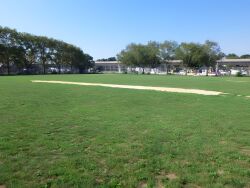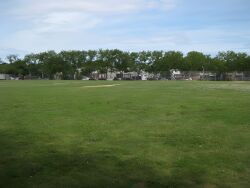Dr. Charles R. Drew Park
Dr. Charles R. Drew Park
What was here before?
This area was inhabited by a Native American tribe called the Jameco or Yamecah (a word meaning “beaver” in Algonquin) when the first Europeans arrived from neighboring Hempstead in 1655 in search of more farmland. This land remained rural through the early 20th century.
In 1946 the City began purchasing land to make way for the Van Wyck Expressway. It acquired hundreds of homes and relocated over 250 homes elsewhere in the neighborhood. However, this property was largely vacant at the time of purchase.
How did this site become a park?
Purchased along with four other parks, this site opened six years later in 1952. It was named for Dr. Charles R. Drew by the City Council the same year. Paid for by the State as part of the City’s arterial development, the playground had handball, basketball, and volleyball courts, roller skating rink, and baseball diamonds.
In 1985, a capital project renovated the playing fields, basketball courts, and other facilities.
Who is this park named for?
Dr. Charles Richard Drew (1904-1950) was a pioneer in the development of blood plasma preservation, as well as an exemplary surgeon and teacher. He was born and raised in Washington, D.C., and later received his bachelor’s degree from Amherst College in 1926. He obtained his medical degree from McGill University in 1933, and two years later he became an instructor and surgeon at Howard University.
In 1940 Drew was the first Black person to earn a Doctor of Medical Science degree from Columbia University. His thesis Banked Blood: A Study on Blood Preservation developed an efficient method for the mass production and shipment of plasma (cell-free sterilized blood) for blood transfusions. That year, when England faced a possible German invasion during World War II, Drew was recruited to run the Blood for Britain Project, which transported blood and plasma overseas to the British military and civilians.
The American Red Cross Blood Bank was established the following year under Drew’s direction. The outgrowth of this pilot program was the American Red Cross Blood Donor Service, which helped save the lives of thousands of American soldiers wounded during the war. However, Red Cross policy prohibited African Americans from donating blood, preventing Drew from participating in the very program he developed. Even after the policy was modified, the organization continued to segregate blood by race, which Drew openly criticized as “unscientific and insulting to African Americans,” and he ultimately resigned his position in protest.
He rejoined Howard University’s Freeman Hospital as department head and Chief of Surgery to train young Black surgeons, which he believed would be his greatest contribution to medicine.
Drew was awarded the Spingarn Medal by the National Association for the Advancement of Colored People (NAACP) in 1944. He received honorary degrees from Virginia State and Amherst Colleges and was one of the first African Americans selected for membership on the American Board of Surgery. On April 1, 1950, Drew was fatally injured in an automobile accident in North Carolina.
Check out your park's Vital Signs
Clean & Safe
Green & Resilient
Empowered & Engaged Users
Share your feedback or learn more about how this park is part of a
Vital Park System




